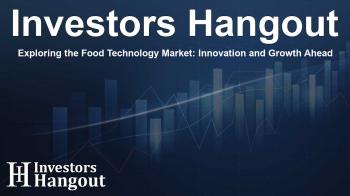Exploring the Food Technology Market: Innovation and Growth Ahead

Overview of the Food Technology Market
The global food technology market is experiencing rapid growth, projected to reach USD 538.47 billion by 2034, following a remarkable trajectory from USD 208.74 billion in 2024. This growth is driven by a compound annual growth rate (CAGR) of 9.94% from 2025 to 2034. A significant contributing factor to this increase is the surge in investments in food processing and the implementation of innovative technologies aimed at ensuring food safety and sustainability.
Driving Innovations in Food Processing
As consumer preferences shift towards healthier and sustainable food options, food processing innovations play a vital role. Companies are adopting advanced processing technologies that enhance food safety, hygiene, and traceability through systems like blockchain. These technological advancements not only aim to maintain food quality but also reduce waste and streamline manufacturing processes.
The Impact of Consumer Demand
The growing public awareness surrounding nutrition and food safety pushes brands to explore innovative solutions to meet these demands. The need for safe, healthy, and sustainable food choices is propelling the food technology sector forward, creating numerous opportunities for brands who invest in innovation and technology.
Market Trends and Regional Analysis
The Asia-Pacific region recently led the food technology market with a notable market share of 32% in 2024, reflecting the rapid adoption of eCommerce and food delivery applications. In North America, the technological advancements in food processing and artificial intelligence are anticipated to foster significant growth, catering to the increasing consumer demand for technology-enhanced food products.
Key Highlights
- Asia Pacific dominated the market with substantial advancements in food technology.
- The North American sector is driven by the rise of smart food solutions and software adoption.
- The hardware segment accounted for approximately 43% market share in 2024 and is expected to grow.
- By application, the food science segment holds the maximum market share while delivery solutions are climbing rapidly.
- Investment in the fish, meat, and seafood segment continues to peak due to high demand.
The Role of AI in Food Technology
Artificial Intelligence (AI) is shaping the food technology market in transformative ways. From enhancing operational efficiencies to ensuring food safety through predictive analytics, AI is becoming crucial across the supply chain. Its application ranges from precision agriculture to smarter inventory management and product development, enabling companies to innovate and adapt more effectively to market trends.
Case Study: Chef Robotics
Chef Robotics exemplifies how technology is revolutionizing food manufacturing. Specializing in AI-powered robotic systems, Chef Robotics streamlines food production processes, significantly cut labor costs, and enhances food quality. Their innovative robotic solutions have allowed for efficient handling of food preparation and packaging, showcasing the potential AI has in this sector.
Challenges and Opportunities in the Market
Despite significant growth prospects, the food technology market faces challenges such as disruptions in the food supply chain due to external factors like political unrest or climatic issues. Addressing these challenges requires robust communication systems between producers, retailers, and consumers to facilitate a cohesive supply chain.
Future Prospects
Opportunities abound for growth, especially with advancements in robotics and automation. These technologies promise to revolutionize food packaging and inventory management, further enhancing operational efficiency. As the market continues to evolve, businesses that invest in innovation will be best positioned to thrive.
Frequently Asked Questions
What is the current size of the food technology market?
The global food technology market was valued at USD 208.74 billion in 2024 and is expected to reach USD 538.47 billion by 2034.
What are the key drivers of growth in the food technology market?
Major drivers include increasing investments in food processing, the adoption of innovative technologies, and rising consumer demand for food safety and sustainability.
What role does AI play in the food technology market?
AI enhances efficiency and safety in food production, improves decision-making, and helps in product development based on consumer preferences.
Which regions lead in the food technology market?
Asia Pacific holds a significant market share, but North America is also rapidly expanding, driven by technological advancements.
What challenges does the food technology market face?
Challenges include potential disruptions in supply chains due to political and climatic issues, requiring proactive communication among stakeholders.
About The Author
Contact Logan Wright privately here. Or send an email with ATTN: Logan Wright as the subject to contact@investorshangout.com.
About Investors Hangout
Investors Hangout is a leading online stock forum for financial discussion and learning, offering a wide range of free tools and resources. It draws in traders of all levels, who exchange market knowledge, investigate trading tactics, and keep an eye on industry developments in real time. Featuring financial articles, stock message boards, quotes, charts, company profiles, and live news updates. Through cooperative learning and a wealth of informational resources, it helps users from novices creating their first portfolios to experts honing their techniques. Join Investors Hangout today: https://investorshangout.com/
The content of this article is based on factual, publicly available information and does not represent legal, financial, or investment advice. Investors Hangout does not offer financial advice, and the author is not a licensed financial advisor. Consult a qualified advisor before making any financial or investment decisions based on this article. This article should not be considered advice to purchase, sell, or hold any securities or other investments. If any of the material provided here is inaccurate, please contact us for corrections.

